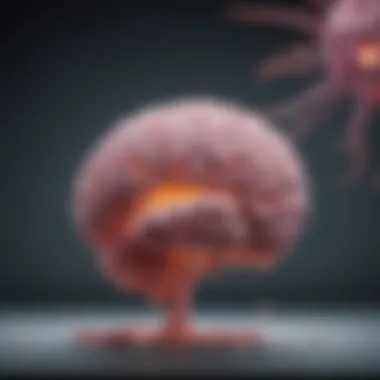Understanding Triple Negative Breast Cancer Metastasis to Brain


Intro
Triple negative breast cancer (TNBC) represents a particularly aggressive form of breast cancer characterized by the absence of estrogen receptors, progesterone receptors, and minimal expression of the human epidermal growth factor receptor 2 (HER2). This unique profile translates into a lack of targeted therapies, making treatment a significant challenge. Importantly, TNBC has a higher propensity to metastasize compared to other subtypes, with brain metastasis being one of the most critical complications of the disease.
Understanding the mechanisms of TNBC metastasis to the brain is essential, as this phenomenon impacts the prognosis and the quality of life for affected individuals. Research indicates that TNBC cells have enhanced migratory and invasive properties, facilitating their spread to the central nervous system. Recent studies suggest that the microenvironment, immune response, and alterations in cellular signaling pathways play a vital role in this metastatic process. Both clinical and laboratory investigations contribute to understanding the pathways involved in TNBC brain metastasis, ultimately aiming to improve therapeutic outcomes.
Methodology
Overview of research methods used
The examination of TNBC metastasis to the brain employs a multifaceted approach, combining clinical data analysis with laboratory studies. Primary research methods include cohort studies, where patient data is collected to identify patterns and outcomes related to brain metastasis. Additionally, preclinical models, such as animal models and cell cultures, are used to simulate TNBC behavior and treatment responses.
Data collection techniques
Data collection involves various techniques:
- Medical records analysis: Gathering detailed information from cancer registries and patient histories.
- Imaging studies: Utilizing MRI and PET scans to track the presence of brain metastases.
- Biopsies: Examining tumor samples to study the cellular characteristics and molecular markers indicative of TNBC.
- Laboratory assays: Performing tests to measure the aggressiveness of TNBC cells under different conditions.
These methods collectively provide insights into the prevalence and characteristics of TNBC brain metastasis.
Future Directions
Upcoming trends in research
Recent advancements hint at a more comprehensive understanding of TNBC mechanisms as research progresses. There is growing interest in exploring the role of the tumor microenvironment and immune interactions in TNBC brain metastasis.
Areas requiring further investigation
Key areas for future research include:
- Developing more effective targeted therapies aimed specifically at TNBC variants.
- Investigating the genetic and epigenetic factors contributing to brain metastasis.
- Studying the potential for immunotherapy in the treatment of TNBC brain metastasis.
By addressing these crucial areas, researchers aim to formulate innovative strategies that can help manage this aggressive cancer type and ultimately enhance the survival and quality of life for patients.
Prologue to Triple Negative Breast Cancer
Triple Negative Breast Cancer (TNBC) represents a unique and challenging category of breast cancer. Its understanding is critical, especially in the context of metastasis, where cancer spreads from the primary site to other parts of the body, such as the brain. With TNBC being more aggressive than other breast cancer types and lacking specific hormonal receptors, it presents distinct clinical characteristics.
A comprehensive grasp of TNBC is essential for multiple reasons. Firstly, it emphasizes the need for targeted research and treatment. Currently, the options available for TNBC are limited compared to hormone-receptor-positive breast cancers. Moreover, understanding the epidemiology of TNBC helps identify populations at risk and informs preventive strategies.
Additionally, studying the biological characteristics of TNBC aids in developing innovative treatment approaches and improving treatment outcomes. As such, exploring this cancer subtype can yield vital insights for researchers, healthcare professionals, and patients alike, facilitating better management of this aggressive disease. Clearly, an in-depth exploration of TNBC establishes a foundation upon which we can build our understanding and treatment methodologies for its metastatic behavior.
Defining Triple Negative Breast Cancer
Triple Negative Breast Cancer is defined by the absence of three key receptors: estrogen, progesterone, and the human epidermal growth factor receptor 2 (HER2). This lack of receptors means that standard hormone therapies and targeted treatments used in other breast cancer types are ineffective. Consequently, the absence of these treatments makes TNBC more complex to manage. It often results in poorer prognosis compared to other breast cancer forms.
This cancer type is predominantly diagnosed in younger women and tends to be more prevalent among African American and Hispanic patients. Additionally, TNBC is frequently associated with more aggressive tumor behavior and higher rates of recurrence.


Epidemiological Overview
The epidemiology of Triple Negative Breast Cancer provides valuable insights into its incidence and demographic distinctions. Epidemiological studies indicate that TNBC accounts for approximately 10-20% of all breast cancers. The peaks in incidence are notably seen in younger women, with a significant proportion diagnosed before age 50.
Statistical data highlights that the risk factors for TNBC include genetic predispositions, particularly mutations in the BRCA1 gene. Environment and lifestyle factors also contribute, although these factors require further exploration.
"Understanding the epidemiological nuances of TNBC is vital for crafting targeted interventions and preventive strategies."
Biological Characteristics
Biologically, Triple Negative Breast Cancer is marked by several key features. Tumors are often histologically grade 3, indicating a high degree of abnormality and aggressive behavior. Furthermore, a significant proportion of TNBC patients exhibit a high proliferative index, suggesting faster tumor growth. The tumors tend to be more vascular and have distinct patterns of metastasis compared to other forms of breast cancer.
At the molecular level, TNBC can be divided into several subtypes using gene expression profiling, including basal-like and claudin-low subtypes. These subtypes exhibit different characteristics in terms of response to treatments and overall prognosis. Understanding these biological markers can lead to potential targeted therapies, which is an area of active research.
Understanding Metastasis
Understanding metastasis is crucial to comprehending the complexity of cancer, particularly triple negative breast cancer (TNBC). Metastasis refers to the process by which cancer cells spread from the original tumor site to other parts of the body. This process significantly complicates treatment strategies and negatively impacts prognosis. By delving into the definitions and mechanisms of metastasis, healthcare professionals and researchers can better address the challenges posed by TNBC, especially concerning its propensity to spread to the brain.
Definition and Process of Metastasis
Metastasis involves several steps:
- Local invasion: Cancer cells invade nearby tissues. This is the first step in the metastatic process.
- Intravasation: Cancer cells enter the bloodstream or lymphatic system after breaching the walls of blood vessels.
- Survival in circulation: Tumor cells must evade the immune system while traveling through the bloodstream.
- Extravasation: Cells exit the bloodstream and invade distant tissues.
- Formation of secondary tumors: Finally, cells proliferate at the new site, forming metastatic tumors.
This multi-step process emphasizes the biological adversities that TNBC presents. By understanding the specifics of each of these stages, research can focus on disrupting the pathways that facilitate metastasis, thus providing avenues for therapeutic intervention.
Factors Influencing Metastatic Behavior
Several factors play significant roles in the metastatic behavior of cancer cells:
- Tumor Microenvironment: The environment surrounding the tumor can influence its ability to invade and spread. Factors such as extracellular matrix components and supporting cells can either promote or inhibit metastasis.
- Cellular Characteristics: Genetic alterations in cancer cells enhance their survival and invasion capabilities. Changes such as epithelial-mesenchymal transition (EMT) allow cells to become more mobile and invasive.
- Immune Evasion: Some cancers develop mechanisms to evade detection and destruction by the immune system, an essential factor in successful metastasis.
- Circulating Tumor Cells (CTCs): These cells can provide information on the metastatic potential of the primary tumor, making them valuable in research and clinical practice.
By examining these factors, particularly in the context of TNBC, researchers can identify potential targets for therapy. Enhancing understanding of how these elements interrelate might lead to strategies that can inhibit the spread of cancer, particularly to critical areas such as the brain.
Triple Negative Breast Cancer and Brain Metastasis
Understanding triple negative breast cancer (TNBC) and its tendency to metastasize to the brain is crucial for advancing patient care and treatment strategies. TNBC is often considered aggressive due to its biological characteristics, which complicate management and significantly affect patient outcomes. Brain metastasis represents a severe complication in these patients, indicating a need for detailed knowledge in this area.
The importance of addressing brain metastasis in TNBC lies in several factors:
- Severity of the Condition: Brain metastases can lead to cognitive decline and diminished quality of life. Recognizing this can help instigate timely intervention.
- Treatment Challenges: TNBC does not respond to hormonal therapies or therapies that target HER2 receptors, making treatment options limited once metastasis occurs.
- Need for Research: Studying the extent and mechanisms of metastasis can foster innovative therapies and improved diagnostic tools.
Incidence and Prevalence of Brain Metastasis
The incidence of brain metastasis in TNBC patients is significantly higher than in women with other breast cancer subtypes. Studies show that approximately 10-30% of patients with TNBC will develop brain metastases during their disease course. This relates closely to the aggressive nature of TNBC, with faster growth rates and a higher proclivity for spreading to distant organs, including the brain.
Factors associated with heightened risk of brain metastasis include:
- Age: Younger patients typically demonstrate an increased risk.
- Initial Tumor Size: Larger tumors at diagnosis correlate with higher metastasis rates.
- Lymph Node Involvement: Presence of cancer in axillary lymph nodes increases the likelihood of brain metastasis.


Pathways of Metastasis to the Brain
Metastasis to the brain occurs through several pathways. Understanding these pathways is essential. The most prevalent mechanism involves the hematogenous route, where cancer cells enter the bloodstream and migrate to the brain. After reaching the brain, these cells must adhere to the vascular endothelium and penetrate the blood-brain barrier (BBB) to proliferate.
Key aspects involve:
- Cell Migration: Tumor cells utilize various pathways, including matrix metalloproteinases (MMPs), to degrade surrounding tissues and facilitate migration.
- Invasion of the BBB: The BBB serves as a critical barrier, which tumor cells must breach. Factors like increased expression of certain receptors help in this process.
- Microenvironment Adaptation: Once in the brain, tumor cells adapt to the microenvironment. This adaptation involves altering their metabolism and signaling pathways.
Histological and Molecular Features in Brain Metastasis
The histological features of TNBC brain metastases may differ from primary breast tumors. Tumor cells often lose the expression of some surface markers and exhibit distinct morphological changes. These changes can complicate diagnosis and treatment.
Some characteristic features include:
- Cellular Heterogeneity: Metastatic cells often show increased variation in cellular structure compared to the primary tumor.
- Molecular Alterations: Common alterations include mutations in genes such as TP53 and PIK3CA, which can influence treatment response.
- Stromal Interactions: Host brain cells interact with metastatic cells, creating a specific microenvironment that influences tumor behavior and treatment resistance.
Understanding these histological and molecular features is pivotal for developing targeted therapies aimed at improving patient outcomes.
Clinical Implications
Understanding the clinical implications of triple negative breast cancer (TNBC) metastasis to the brain is critical for enhancing patient care and treatment outcomes. As TNBC is an aggressive form of breast cancer that lacks hormone receptors and HER2 protein, it poses unique challenges, particularly when it spreads to the central nervous system. Identifying the symptoms and achieving timely diagnoses can drastically alter the prognosis of affected patients. Furthermore, evaluating the impact of brain metastasis on overall survival is crucial for informing treatment decisions.
Symptoms and Diagnosis
When TNBC metastasizes to the brain, patients may experience a range of distinct symptoms. Common neurologic manifestations include headaches, seizures, and cognitive changes. These symptoms can sometimes be mistaken for benign conditions, which complicates timely diagnosis. Other indicative signs could involve balance issues, visual disturbances, and general weakness.
To accurately diagnose brain metastasis, clinicians often utilize various diagnostic imaging modalities. Magnetic Resonance Imaging (MRI) is frequently employed as it provides high-resolution images of soft tissue, enabling detection of tumors in the brain. Another useful tool is Computed Tomography (CT) scans, which can reveal structural abnormalities associated with metastases.
Early diagnosis is paramount. The earlier brain metastases are detected, the better the chances for effective treatment. Therefore, healthcare professionals should maintain a high index of suspicion for chest cancer patients, particularly those with TNBC, who report any new neurological symptoms.
Impact on Patient Prognosis
The prognosis for patients with TNBC who develop brain metastases is generally poor. Studies indicate that these patients often have a reduced survival rate compared to those with metastases in other sites. Factors influencing prognosis may include the number and size of brain lesions, as well as the patient's overall health and response to prior treatments.
Metastatic brain tumors can lead to significant morbidity. This includes cognitive dysfunction, impaired mobility, and a general decline in quality of life. Evaluating the overall impact on the patient's prognosis necessitates a multi-disciplinary approach, as oncologists, neurologists, and palliative care teams may need to collaborate for comprehensive management.
"Understanding the clinical implications of brain metastasis in TNBC aids in the early recognition of symptoms, facilitating better patient management and treatment outcomes."
By focusing on these aspects, healthcare providers can significantly improve the trajectory of care for individuals battling this complex disease.
Current Treatment Strategies
The management of triple negative breast cancer (TNBC) that has metastasized to the brain presents unique challenges. Understanding current treatment strategies is vital for healthcare professionals and researchers. This section will outline the obstacles faced in therapy, standard approaches currently employed, and innovative strategies being explored.
Challenges in Treatment of Brain Metastases
Treating brain metastases from TNBC is notably complex. Several factors contribute to these challenges:
- Blood-Brain Barrier: The blood-brain barrier (BBB) restricts the passage of many chemotherapeutic agents, making it difficult to deliver adequate dosing to brain tumors.
- Tumor Aggressiveness: TNBC is characterized by aggressive biology. This often leads to rapid tumor growth and proliferation, creating urgency in treatment and potential for poorer outcomes.
- Patient Health: Patients may present with varying degrees of pre-existing comorbidities, especially after extended treatment for breast cancer. Overall health impacts the feasibility and effectiveness of treatment options.
- Limited Options: There are fewer targeted therapies approved for TNBC compared to other breast cancer subtypes, which reduces the available options for effectively managing brain metastases.


Standard Therapeutic Approaches
Current standard treatment modalities for brain metastasis from TNBC include:
- Surgery: For patients with accessible tumors, surgical resection can provide immediate relief from symptoms and reduce tumor burden. However, recurrence is common, necessitating adjuvant therapies.
- Radiation Therapy: Stereotactic radiosurgery and whole-brain radiation therapy are commonly employed to target metastatic lesions. This treatment helps control tumor growth but raises concerns about radiation-induced cognitive decline over time.
- Chemotherapy: Systemic chemotherapy remains a cornerstone treatment for TNBC. Agents such as docetaxel and carboplatin are utilized, but their effectiveness may be limited in the brain due to the aforementioned BBB issue.
Despite these standard approaches, outcomes are often suboptimal. Hence the exploration of newer strategies is essential.
Novel Therapeutic Strategies Under Investigation
Research is ongoing to explore innovative treatments for TNBC brain metastasis. Areas of focus include:
- Targeted Therapies: Ongoing studies are evaluating inhibitors that target specific pathways relevant to TNBC, such as the androgen receptor or DNA repair mechanisms.
- Immunotherapy: Immune checkpoint inhibitors, like pembrolizumab, are being investigated for their potential to harness the immune system in targeting metastatic lesions.
- Nanoparticle Delivery Systems: Novel delivery systems utilizing nanoparticles show promise in crossing the BBB more effectively, allowing for improved drug delivery directly to the tumor site.
Innovative strategies could enhance treatment efficacy and patient quality of life.
Research Developments
Research on triple negative breast cancer (TNBC) and its tendency to metastasize to the brain is gaining momentum. The significance of exploring this area cannot be understated. As one of the most aggressive forms of breast cancer, TNBC presents unique challenges in treatment and management. Increased understanding of the biological mechanisms, patterns of incidence, and treatment responses can significantly impact patient outcomes. Research not only aims to unveil the complexities of TNBC but also offers the potential for innovative therapies.
Recent Studies on TNBC and Brain Metastasis
Recent studies have shed light on the mechanisms that facilitate brain metastasis of TNBC. Notably, research from peer-reviewed journals highlights various genetic and molecular abnormalities in TNBC cells that enable them to invade the central nervous system. For instance, studies show that the presence of specific proteins plays a crucial role in the invasion process.
- Key Findings in Recent Research:
- Enhanced expression of certain growth factors and receptors.
- Identification of biomarkers signaling potential for brain metastasis.
- Understanding tumor microenvironment interactions enables insights into metastatic behavior.
These studies emphasize not only the biological but also the clinical relevance of this metastasis type. Patients with TNBC and brain metastases often face distinct challenges compared to other metastatic cancers. Hence, research findings are vital for devising targeted therapies that can penetrate the blood-brain barrier effectively.
"Recent advancements in understanding TNBC's metastatic nature are paving the way for better treatment options and improved patient monitoring."
Future Directions in Research
The horizon for TNBC and brain metastasis research is broad and evolving. Future studies will likely focus on several critical areas:
- Targeted Therapeutics: Efforts to develop specific agents that can inhibit the identified pathways of metastasis to the brain. The success of immunotherapies and their application in TNBC will be of particular interest.
- Biomarker Discovery: Identifying new biomarkers will continue to be crucial. This could not only aid in detecting metastasis early but also provide targets for new treatment modalities.
- Combination Treatment Strategies: Research may address the efficacy of combining existing therapies with novel agents to enhance treatment effectiveness against brain metastases.
- Expanding Clinical Trials: Larger and more comprehensive clinical trials will be necessary to assess the safety and efficacy of new treatments. This could lead to better understanding variations in patient responses based on genetic profiles.
The End and Future Perspectives
Understanding the intricacies of triple negative breast cancer (TNBC) metastasis to the brain is crucial. This section synthesizes the information discussed throughout the article and highlights the relevance of ongoing research. TNBC is distinct due to its aggressive nature and the complex mechanisms involved in its metastasis, particularly to the brain. The implications for patient care are profound, as brain metastasis significantly impacts prognosis and quality of life.
Summary of Key Findings
This article presented several key findings:
- TNBC is characterized by the absence of estrogen, progesterone, and HER2 receptors, leading to its aggressive behavior.
- Brain metastasis in TNBC is prevalent, often occurring due to unique biological pathways that differ from other breast cancer subtypes.
- Current treatment strategies present challenges, including limited options and severe side effects.
- Research indicates a need for more effective therapies aimed specifically at addressing the mechanisms driving brain metastasis in TNBC.
- Ongoing studies are vital to uncovering novel therapeutic targets and strategies for better management of this condition.
Call for Continued Research and Awareness
The call for ongoing research and awareness cannot be overstated. Increased understanding of TNBC will facilitate the development of targeted treatment strategies. In addition to laboratory research, raising public awareness about TNBC and its complications is essential. Healthcare professionals must remain informed about the latest developments in this field to provide optimal care. \
"In depth knowledge and timely studies on TNBC can improve patient outcomes significantly."
To summarize, the future of TNBC management hinges on collaborative efforts among researchers, clinicians, and awareness campaigns. These partnerships are key to informing treatment pathways and enhancing patient support.







